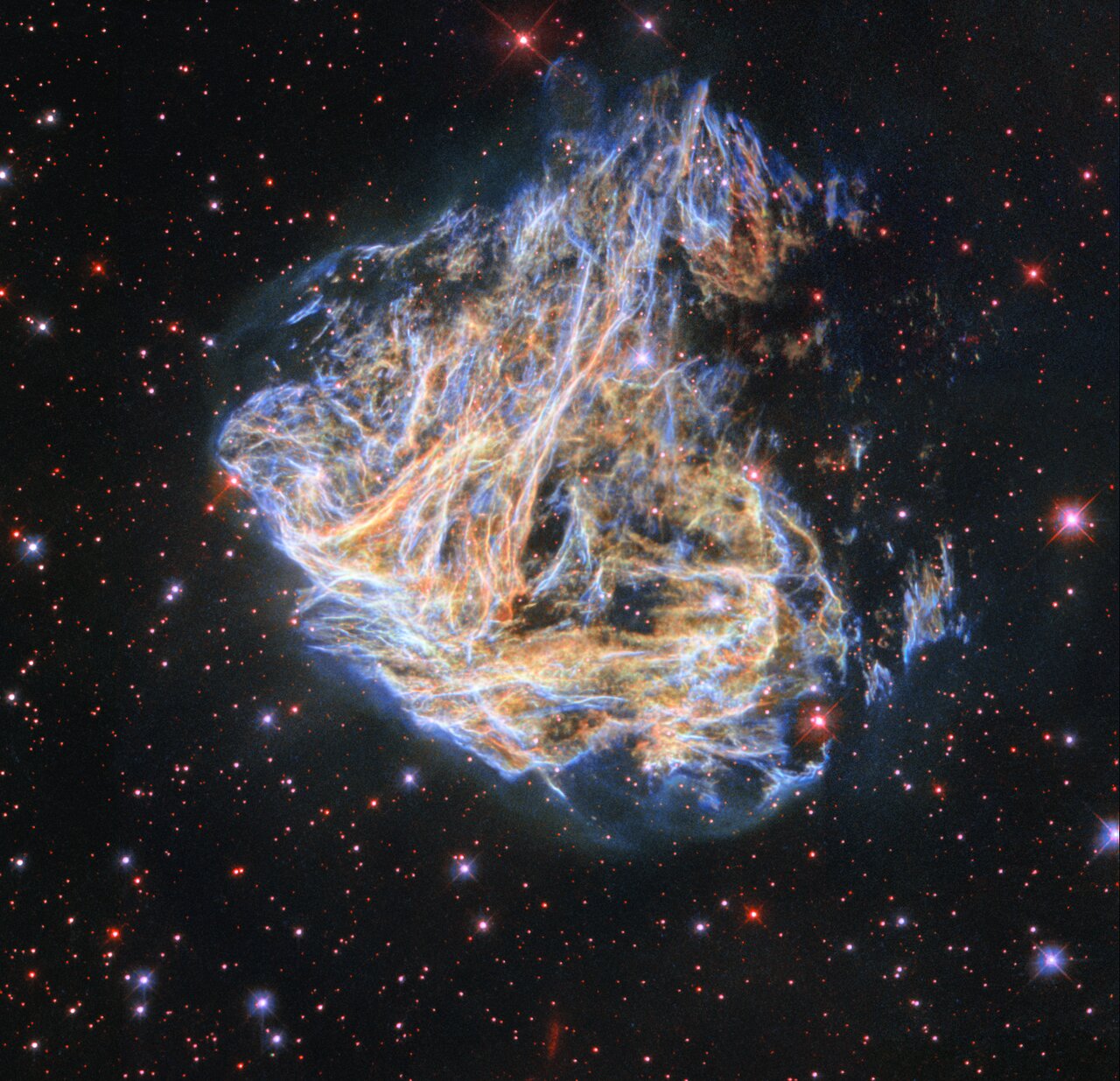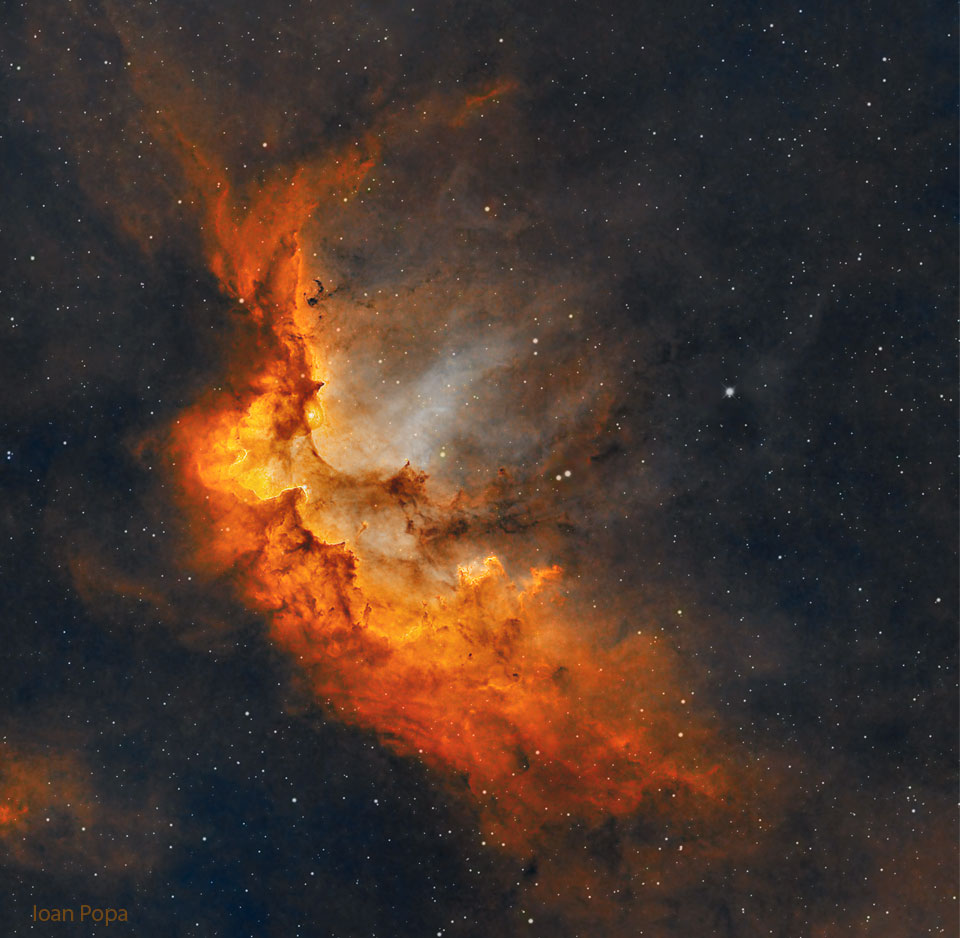Blog
Shreds of the luridly coloured supernova remnant DEM L 190 seem to billow across the screen in this image from the NASA/ESA Hubble Space Telescope. The delicate sheets and intricate filaments are debris from the cataclysmic death of a massive star that once lived in the Large Magellanic Cloud, a small satellite galaxy of the Milky Way. DEM L 190 — also known as LMC N49 — is the brightest supernova remnant in the Large Magellanic Cloud and lies approximately 160 000 light-years away from Earth in the constellation Dorado.
This striking image was created with data from two different astronomical investigations, using one of Hubble’s retired instruments, the Wide Field Planetary Camera 2 (WFPC2). This instrument has since been replaced by the more powerful Wide Field Camera 3, but during its operational lifetime it contributed to cutting-edge science and produced a series of stunning public outreach images. The first of the two WFPC2 investigations used DEM L 190 as a natural laboratory in which to study the interaction of supernova remnants and the interstellar medium, the tenuous mixture of gas and dust that lies between stars. In the second project, astronomers turned to Hubble to pinpoint the origin of a Soft Gamma-ray Repeater, an enigmatic object lurking in DEM L 190 which repeatedly emits high-energy bursts of gamma rays.
This is not the first image of DEM L 190 to be released to the public — a previous Hubble portrait of this supernova remnant was published in 2003. This new image incorporates additional data and improved image processing techniques, making this spectacular celestial fireworks display even more striking!
[Image description: A supernova remnant, in the shape of a flame, occupies the centre and top. It is made of many long strands and thin layers of gas, that brightly glow orange and blue. Faint gas clouds outline its edges. It is surrounded by several scattered blue and red stars, and the background is black and filled with small red stars.

Randall Stuart Newman (born November 28, 1943 LA, CA) is an American singer-songwriter, arranger, composer, and pianist known for his Southern-accented singing style, early Americana-influenced songs (often with mordant or satirical lyrics), and various film scores. His best-known songs as a recording artist are “Short People” (1977), “I Love L.A.” (1983), and “You’ve Got a Friend in Me” (1995), while other artists have enjoyed more success with cover versions of his “Mama Told Me Not to Come” (1966), “I Think It’s Going to Rain Today” (1968) and “You Can Leave Your Hat On” (1972).
Born in Los Angeles to an extended family of Hollywood film composers, Newman began his songwriting career at the age of 17, penning hits for acts such as the Fleetwoods, Cilla Black, Gene Pitney, and the Alan Price Set. In 1968, he made his formal debut as a solo artist with the album Randy Newman, produced by Lenny Waronker and Van Dyke Parks. Four of Newman’s non-soundtrack albums have charted in the US top 40: Sail Away (1972), Good Old Boys (1974), Little Criminals(1977), and Harps and Angels (2008).
Since the 1980s, Newman has worked mostly as a film composer. He has scored nine Disney–Pixar animated films, including all four Toy Story films (1995–2019), A Bug’s Life (1998), both Monsters, Inc. films (2001, 2013), and the first and third Cars films (2006, 2017), as well as Disney’s James and the Giant Peach (1996) and The Princess and the Frog (2009). His other film scores include Cold Turkey (1971), Ragtime (1981), The Natural (1984), Awakenings (1990), Pleasantville (1998), Meet the Parents (2000), Seabiscuit (2003), and Marriage Story (2019).
Newman has received twenty-two Academy Award nominations in the Best Original Score and Best Original Song categories and has won twice in the latter category, contributing to the Newmans being the most nominated Academy Award extended family, with a collective 92 nominations in various music categories. He has also won three Emmys, seven Grammy Awards and the Governor’s Award from the Recording Academy. In 2007, he was recognized by the Walt Disney Company as a Disney Legend. He was inducted into the Songwriters Hall of Fame in 2002 and to the Rock and Roll Hall of Fame in 2013.
more...Roy McCurdy (born November 28, 1936) is a jazz drummer.
Before joining Cannonball Adderley‘s Quintet in 1965 and staying with the band until Adderley’s death in 1975, he had played with Chuck and Gap Mangione in the Jazz Brothers (1960–1961), as well as with Bobby Timmons, Betty Carter and Sonny Rollins (1963–1964), appearing on the classic 1963 album Sonny Meets Hawk!
He attended the Eastman School of Music from sixteen to eighteen, during which time he also played professionally with Roy Eldridge and with Eddie Vinson at seventeen. In 1960 he joined the Art Farmer – Benny Golson Jazztet and remained for two years.
Among the influences he cites Louie Bellson, Shelly Manne, Sam Woodyard, Buddy Rich, Papa Jo Jones, Philly Joe Jones and the bands of Duke Ellington, Jimmie Lunceford and Lionel Hampton.
He has also played and/or recorded with Count Basie, Wes Montgomery, Ella Fitzgerald, Sarah Vaughan, Carmen McRae, Joe Williams, Herbie Hancock, Oscar Peterson, Bud Powell, Art Pepper, and the jazz rock group Blood, Sweat and Tears, etc.
more...Leandro “Gato” Barbieri (November 28, 1932 – April 2, 2016) was an Argentine jazz tenor saxophonist who rose to fame during the free jazz movement in the 1960s and is known for his Latin jazz recordings of the 1970s. His nickname, Gato, is Spanish for “cat”.
Born to a family of musicians, Barbieri began playing music after hearing Charlie Parker‘s “Now’s the Time”. He played the clarinetand later the alto saxophone while performing with Argentine pianist Lalo Schifrin in the late 1950s. By the early 1960s, while playing in Rome, he also worked with the trumpeter Don Cherry. By now influenced by John Coltrane‘s late recordings, as well as those from other free jazz saxophonists such as Albert Ayler and Pharoah Sanders, he began to develop the warm and gritty tone with which he is associated. In the late 1960s, he was fusing music from South America into his playing and contributed to multi-artist projects like Charlie Haden‘s Liberation Music Orchestra and Carla Bley‘s Escalator Over The Hill. His score for Bernardo Bertolucci‘s 1972 film Last Tango in Paris earned him a Grammy Award and led to a record deal with Impulse! Records.
more...Gigi Gryce (born George General Grice Jr.; November 28, 1925 – March 14, 1983), later Basheer Qusim, was an American jazz saxophonist, flautist, clarinetist, composer, arranger, and educator.
While his performing career was relatively short, much of his work as a player, composer, and arranger was quite influential and well-recognized during his time. However, Gryce abruptly ended his jazz career in the 1960s. This, in addition to his nature as a very private person, has resulted in very little knowledge of Gryce today. Several of his compositions have been covered extensively (“Minority“, “Social Call”, “Nica’s Tempo”) and have become minor jazz standards. Gryce’s compositional bent includes harmonic choices similar to those of contemporaries Benny Golson, Tadd Dameron and Horace Silver. Gryce’s playing, arranging, and composing are most associated with the classic hard bop era (roughly 1953–1965). He was a well-educated composer and musician, and wrote some classical works as a student at the Boston Conservatory. As a jazz musician and composer he was very much influenced by the work of Charlie Parker and Thelonious Monk.
https://www.youtube.com/watch?v=OaFQDYd5C-8
more...After the remnants of Hurricane Florence passed over the Jersey Shore, New Jersey, USA in 2018, the Sun came out in one direction but something quite unusual appeared in the opposite direction: a hall of rainbows. Over the course of a next half hour, to the delight of the photographer and his daughter, vibrant supernumerary rainbows faded in and out, with at least five captured in this featured single shot. Supernumerary rainbows only form when falling water droplets are all nearly the same size and typically less than a millimeter across. Then, sunlight will not only reflect from inside the raindrops, but interfere, a wave phenomenon similar to ripples on a pond when a stone is thrown in. In fact, supernumerary rainbows can only be explained with waves, and their noted existence in the early 1800s was considered early evidence of light’s wave nature.

Randal Edward Brecker (born November 27, 1945) is an American trumpeter, flugelhornist, and composer. His versatility has made him a popular studio musician who has recorded with acts in jazz, rock, and R&B.
Brecker was born on November 27, 1945, in the Philadelphia suburb of Cheltenham to a musical family. His father Bob (Bobby) was a lawyer who played jazz piano and his mother Sylvia was a portrait artist. Randy described his father as “a semipro jazz pianist and trumpet fanatic. In school when I was eight, they only offered trumpet or clarinet. I chose trumpet from hearing Diz, Miles, Clifford, and Chet Baker at home. My brother (Michael Brecker) didn’t want to play the same instrument as I did, so three years later he chose the clarinet!” Randy’s father, Bob, was also a songwriter and singer who loved to listen to recordings of the great jazz trumpet players such as Miles Davis, Dizzy Gillespie and Clifford Brown. He took Randy and his younger brother Michael Brecker to see Davis, Thelonious Monk, Duke Ellington, and many other jazz icons. Brecker attended Cheltenham High School from 1959 to 1963 and then Indiana University from 1963 to 1966 studying with Bill Adam, David Baker and Jerry Coker and later moved to New York and performed with Clark Terry‘s Big Bad Band, the Duke Pearson and the Thad Jones/Mel Lewis Orchestra.
more...Lyle David Mays (November 27, 1953 – February 10, 2020) was an American jazz pianist, composer, and member of the Pat Metheny Group. Metheny and Mays composed and arranged nearly all of the group’s music, for which Mays won eleven Grammy Awards.
While growing up in rural Wisconsin, Mays had a lot of curiosity but had to learn many things all by himself due to a lack of available resources and information. He had four main interests: chess, mathematics, architecture, and music. His mother Doris played piano and organ, and his father Cecil, a truck driver, taught himself to play guitar by ear. His teacher allowed him to practice improvisation after the structured elements of the lesson were completed. At the age of nine, he played the organ at a family member’s wedding, and fourteen he began to play in church.During his senior year of high school, at summer national stage band camp in Normal, Illinois, he was introduced to jazz pianist Marian McPartland.
Bill Evans at the Montreux Jazz Festival and Filles de Kilimanjaro by Miles Davis (both recorded in 1968) were important influences. He attended the University of North Texas after transferring from the University of Wisconsin–Eau Claire. He composed and arranged for the One O’Clock Lab Band and was the composer and arranger for the Grammy Award-nominated album Lab 75.
After leaving the University of North Texas, Mays toured in the US and Europe with Woody Herman‘s jazz big band, Thundering Herds, for approximately eight months. In 1975 he met Pat Metheny at the Wichita Jazz Festival and later founded the Pat Metheny Group. Mays had an extraordinary career as a core musical architect and sound designer of the group for more than three decades. He won total 11 Grammy awards and was nominated 23 times.
more...James Marshall “Jimi” Hendrix (born Johnny Allen Hendrix; November 27, 1942 – September 18, 1970 Seattle, WA) was an American guitarist, singer, and songwriter. Although his mainstream career spanned only four years, he is widely regarded as one of the most influential electric guitarists in the history of popular music, and one of the most celebrated musicians of the 20th century. The Rock and Roll Hall of Fame describes him as “arguably the greatest instrumentalist in the history of rock music.”
Born in Seattle, Washington, Hendrix began playing guitar at the age of 15. In 1961, he enlisted in the US Army, but was discharged the following year. Soon afterward, he moved to Clarksville then Nashville, Tennessee, and began playing gigs on the chitlin’ circuit, earning a place in the Isley Brothers‘ backing band and later with Little Richard, with whom he continued to work through mid-1965. He then played with Curtis Knight and the Squires before moving to England in late 1966 after bassist Chas Chandler of the Animals became his manager. Within months, Hendrix had earned three UK top ten hits with the Jimi Hendrix Experience: “Hey Joe“, “Purple Haze“, and “The Wind Cries Mary“. He achieved fame in the US after his performance at the Monterey Pop Festival in 1967, and in 1968 his third and final studio album, Electric Ladyland, reached number one in the US. The double LP was Hendrix’s most commercially successful release and his first and only number one album. The world’s highest-paid performer, he headlined the Woodstock Festival in 1969 and the Isle of Wight Festival in 1970 before his accidental death in London from barbiturate-related asphyxia on September 18, 1970.
Hendrix was inspired by American rock and roll and electric blues. He favored overdriven amplifiers with high volume and gain, and was instrumental in popularizing the previously undesirable sounds caused by guitar amplifier feedback. He was also one of the first guitarists to make extensive use of tone-altering effects units in mainstream rock, such as fuzz distortion, Octavia, wah-wah, and Uni-Vibe. He was the first musician to use stereophonic phasing effects in recordings. Holly George-Warren of Rolling Stone commented: “Hendrix pioneered the use of the instrument as an electronic sound source. Players before him had experimented with feedback and distortion, but Hendrix turned those effects and others into a controlled, fluid vocabulary every bit as personal as the blues with which he began.”
Hendrix was the recipient of several music awards during his lifetime and posthumously. In 1967, readers of Melody Maker voted him the Pop Musician of the Year and in 1968, Billboard named him the Artist of the Year and Rolling Stone declared him the Performer of the Year. Disc and Music Echo honored him with the World Top Musician of 1969 and in 1970, Guitar Player named him the Rock Guitarist of the Year. The Jimi Hendrix Experience was inducted into the Rock and Roll Hall of Fame in 1992 and the UK Music Hall of Fame in 2005. Rolling Stone ranked the band’s three studio albums, Are You Experienced, Axis: Bold as Love, and Electric Ladyland, among the 100 greatest albums of all time, and they ranked Hendrix as the greatest guitarist and the sixth greatest artist of all time. Details concerning Hendrix’s last day and death are disputed. He spent much of September 17, 1970 in London with Monika Dannemann, the only witness to his final hours. Dannemann said that she prepared a meal for them at her apartment in the Samarkand Hotel around 11 p.m., when they shared a bottle of wine. She drove him to the residence of an acquaintance at approximately 1:45 a.m., where he remained for about an hour before she picked him up and drove them back to her flat at 3 a.m. She said that they talked until around 7 a.m., when they went to sleep. Dannemann awoke around 11 a.m. and found Hendrix breathing but unconscious and unresponsive. She called for an ambulance at 11:18 a.m., and it arrived nine minutes later. Ambulancemen transported Hendrix to St Mary Abbots Hospital where Dr. John Bannister pronounced him dead at 12:45 p.m. on September 18.
https://www.youtube.com/watch?v=6GxIeti5VT0
more...Edward Otha South (November 27, 1904 – April 25, 1962) was an American jazz violinist.
South studied classical music in Budapest, Paris, and Chicago. He turned to jazz because, as a Black musician, there was no room for him in classical music. In the 1920s he was a member of jazz orchestras led by Charlie Elgar, Erskine Tate, and Jimmy Wade. From 1928 to 1930, he was touring in Europe with his band, Eddie South’s Alabamians, with whom he had already made several records. He recorded during this tour as well. During this tour, the Alabamians had an extended stay in Venice, in 1928, at the Luna Hotel.
He led a band in the early 1930s that included Milt Hinton and Everett Barksdale. In 1937 he recorded in Paris with Stephane Grappelli, Django Reinhardt, and Michel Warlop. In 1945 he worked for the studio band at WMGM in New York City. During the 1950s, he was a guest on television with Fran Allison and Dave Garroway and on WGN in Chicago.
more...What powers are being wielded in the Wizard Nebula? Gravitation strong enough to form stars, and stellar winds and radiations powerful enough to create and dissolve towers of gas. Located only 8,000 light years away, the Wizard nebula, featured here, surrounds developing open star cluster NGC 7380. Visually, the interplay of stars, gas, and dust has created a shape that appears to some like a fictional medieval sorcerer. The active star forming region spans 100 about light years, making it appear larger than the angular extent of the Moon. The Wizard Nebula can be located with a small telescope toward the constellation of the King of Aethiopia (Cepheus). Although the nebula may last only a few million years, some of the stars being formed may outlive our Sun.

Miho Nobuzane November 26th was born in Osaka,Japan and began study on classical piano at YAMAHA at the age of 4.She graduated from”Kobe Yamate Woman’s Junior College”as a classical piano major. After graduation,she was inspired by Jazz and studied and started performing Jazz, Brazilian jazz, Latin jazz, and some other world music in different clubs in Japan.
In 1996,she moved into New York and soon took her place in various bands for all kinds of music (Brazilian, Jazz, R&B, Funk, Motown, African fusion, Latin Jazz, Salsa, Caribbean music, and more)and performed all over in U.S and Martinique.
On March.2007,Miho produced her debut album “Make YOU Happy”-Super grooving Brazilian Jazz for making everyone happy!
She has played and/or recorded with;
A legendary drummer Bernard “pretty” Purdie, great R&B singer, Tony Award nominee on “Color Purple”,and Blue Note record label artist Elisabeth Withers,Grupo Saveiro which is twice voted “the best Brazilian group in the United States” by the Brazilian International Press Association,Valtinho, Cafe,Sergio Brandao, Paulo Braga, Ana Lu, Ana Flanca, Raquel Lima , Ricky Sebastian, Rodney Holmes, Bobby Thomas, Kenny Davis, Darryl Hall, John Lee, Stanley Banks, John Benitez, David Gilmore, David Finck, Paul Simon’s bassist Bakithi Kumalo , Abdou Mboup&Waakaw, Dominic Kanza & African Rhythm Machine, Francis Mbappe-FM tribe, African Blue Note, Jimmy Mgwandi&Ntomb’Khona Dlamini-Safro, Jojo Kuo Afro beat collective, Rhythm Nation, Jerry Elcock, Burt Conrad all stars, Buddy Hankerson, A.C Drummer, and many others.
Tina Turner (born Anna Mae Bullock; November 26, 1939 Brownsville, TN) is an American-born Swiss singer and actress. Widely referred to as the “Queen of Rock ‘n’ Roll“, she rose to prominence as the lead singer of the Ike and Tina Turner Revue before launching a successful career as a solo performer.
Turner began her career with Ike Turner‘s Kings of Rhythm in 1957. Under the name Little Ann, she appeared on her first record, “Boxtop“, in 1958. In 1960, she debuted as Tina Turner with the hit duet single “A Fool in Love“. The duo Ike & Tina Turner became “one of the most formidable live acts in history”. They released hits such as “It’s Gonna Work Out Fine“, “River Deep – Mountain High“, “Proud Mary“, and “Nutbush City Limits” before disbanding in 1976.
In the 1980s, Turner launched “one of the greatest comebacks in music history”. Her 1984 multi-platinum album Private Dancer contained the hit song “What’s Love Got to Do with It“, which won the Grammy Award for Record of the Year and became her first and only number one song on the Billboard Hot 100. At age 44, she was the oldest female solo artist to top the Hot 100. Her chart success continued with “Better Be Good to Me“, “Private Dancer“, “We Don’t Need Another Hero (Thunderdome)“, “Typical Male“, “The Best“, “I Don’t Wanna Fight“, and “GoldenEye“. During her Break Every Rule World Tour in 1988, she set a then-Guinness World Record for the largest paying audience (180,000) for a solo performer. Turner also acted in the films Tommy (1975), Mad Max Beyond Thunderdome (1985), and Last Action Hero (1993). In 1993, What’s Love Got to Do with It, a biopic adapted from her autobiography I, Tina: My Life Story, was released. In 2009, Turner retired after completing her Tina!: 50th Anniversary Tour, which is the 15th highest-grossing tour of the 2000s. In 2018, she became the subject of the jukebox musical Tina.
Having sold over 100 million records worldwide, Turner is one of the best-selling recording artists of all time. She has received 12 Grammy Awards, which include eight competitive awards, three Grammy Hall of Fame awards, and a Grammy Lifetime Achievement Award. She is the first black artist and first female to be on the cover of Rolling Stone. Rolling Stone ranked her among the 100 Greatest Artists of All Time and the 100 Greatest Singers of All Time. Turner has a star on the Hollywood Walk of Fame and the St. Louis Walk of Fame. She is a two-time inductee into the Rock and Roll Hall of Fame, with Ike Turner in 1991 and as a solo artist in 2021. She is also a 2005 recipient of the Kennedy Center Honors and Women of the Year award.
more...Arthur Edward George Themen (born 26 November 1939) is a British jazz saxophonist and formerly orthopaedic surgeon. Critic John Fordham has described him as “an appealing presence on the British jazz circuit for over 40 years…. Originally a Dexter Gordon and Sonny Rollins disciple … Themen has proved himself remarkably attentive to the saxophone styles of subsequent generations.”
Themen was born in Manchester, England, where he was involved with the traditional jazz scene in the late 1950s as a self-taught musician, having started playing clarinet as a schoolboy at Manchester Grammar School.
more...More Posts
- Paul Simon
- Pharoah Sanders
- Ray Brown
- Lee Konitz
- Art Tatum
- World Music July Vitraniuk
- Daily Roots The Congos
- Happy Yom Kippur 2024
- Mount Zion Yom Kippur Service
- Cosmos W63 (SNR G082.2+05.3)
- James “Sugar Boy” Crawford
- Nappy Brown
- Guitar Gabriel
- Harmonica Frank
- Tubby Hall
- Jay Epstein
- World Music Abdel Karim Ensemble
- Daily Roots Stephen Marley
- Truth Battleground States
- Nyabinghi Collection
